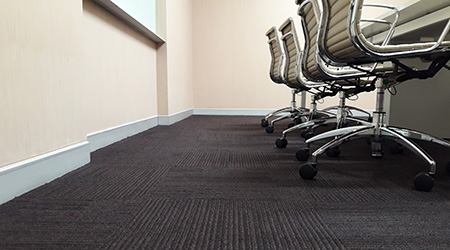
The concept of daytime commercial cleaning flies in the face of everything that makes nighttime service so appealing — working outside the constraints of normal office hours, the ability to run loud machinery without disturbing anyone, and workers showing up the next day to a clean and fresh office. Working during the day, though, offers many unexpected benefits and addresses several key issues that cleaning companies are facing industry wide.
Most strikingly, daytime cleaning programs deal with a problem that almost everyone is struggling with: finding staff. As companies compete for workers, overnight and evening staff are more difficult to come by than ever. Employees aside, the issue of supervision and security is also a factor. Managers don’t necessarily want to spend nights and weekends performing quality checks on jobs that could be done just as effectively at regular hours of the day.
Daytime cleaning almost sounds idyllic, but it also comes with myriad challenges. Most importantly, if a facility commits to a cleaning program that operates during daytime hours, it follows that ample time is allowed for floors and carpets to dry — making the recommendation of equipment and cleaning agents vital.
Process Improvements
In daytime cleaning operations, distributors should recommend a dry -compound carpet cleaner, which allows business as usual to carry on throughout the day while the flooring is being maintained. Combining a dry-compound cleaning agent with a counter-rotating brush (CRB) machine should also be suggested. This reduces the required human effort, reduces water waste, and works more efficiently than other daytime cleaning options.
The ease-of-use that a CRB machine offers helps offset concerns that many businesses considering a daytime cleaning program have; it is daunting to re-vamp an entire process while budgets are shrinking and workforce shortages are a challenge. Ideally, a facility will have a cleaning program that results in the carpet and flooring looking the same each day — providing consistent results at affordable prices. Where are the savings to be found?
Productivity Example
A chain of grocery stores in Minnesota offers a glimpse into how higher productivity tools can make a difference in business operations. The facility is unique in that it is covered entirely in commercial carpeting (except the produce and deli sections), but custodial teams were only able to collect roughly 1/7th of the soil being accumulated in the 30,000-35,000 square feet every day. The store rolled the dice on a new cleaning program, incorporating the quieter CRB machines instead of using their daily extraction process.
For about six weeks, the store switched to a CRB-driven encapsulation process. The new method produced the same visual results as fully extracting the floors on a daily basis, and also saved roughly 15 man-hours per week. Across a 20-store chain, this time savings is significant. It is the kind of free time that allows businesses to pursue projects or tasks that otherwise go onto the wish list.
"Think like Wal-Mart does," says Dane Gregory, owner of 3-D Corporation, and a longtime cleaning consultant based in Stevens Point, Wisconsin. "Vendors for Wal-Mart have a responsibility to get the product to the loading docks as cheaply as possible on their own dime — the store owns the infrastructure from there. They can put it on their shelves cheaper than anyone else can, so they can sell it cheaper than anyone else can. In the commercial cleaning marketplace, we have to run the most efficient operation that we can."
The easiest way to lower overhead is to remove as many indirect labor costs as possible from the equation. This requires productivity, efficiency and a close look at what does and doesn’t work in specific situations. It begins up front; a strong cleaning program is grounded in preventative strategies. Suggest end users start from the outside and work inwards — with the parking lots taken care of and entryway sweeping performed regularly, the amount of soil being brought into the building is already lower, making interiors easy to maintain.
Then, the routine maintenance process takes over. Think about the equipment needs. Most companies attack dirt and debris with brooms and low-decibel vacuums in daytime cleaning programs, but how much debris is being removed? Vacuums are very good at picking up lighter, less dense soils. With regular usage, however, the standard commercial carpet accumulates a higher amount of larger or non-standard debris, such as grains of sand and gravel that works its way slightly below the surface effectiveness of some standard vacuums.
The CRB machine specializes in this task. With bristles that penetrate almost another half-inch beneath the surface of the carpets, it provides lifting and removal power to areas that are often overlooked. Recommend end users combine infrequent use of a hot water extraction unit with the speed and effectiveness of a CRB, which can be a winning combination.
Although extraction equipment has its place, relying heavily on the CRB offers a clear advantage: the dry compound works quickly and quietly, and uses minimal moisture, perfect for a daytime cleaning program. The result is a faster drying time and a higher productivity rate. Recommending a periodic maintenance program that utilizes extraction techniques as a supplemental tool offers the best of both worlds — a bright, clean carpet that facility owners expect with a reduction in labor needs that helps lower the bottom line.
Dealing With Daytime Cleaning Hurdles

 The Down and Dirty on Cleaning in Virus Season
The Down and Dirty on Cleaning in Virus Season How Surfactant Use is Expanding in Commercial Cleaning
How Surfactant Use is Expanding in Commercial Cleaning